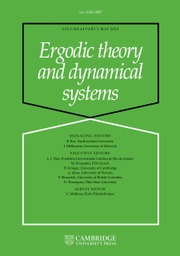Article contents
Invariant measures for substitutions on countable alphabets
Published online by Cambridge University Press: 11 December 2023
Abstract
In this work, we study ergodic and dynamical properties of symbolic dynamical system associated to substitutions on an infinite countable alphabet. Specifically, we consider shift dynamical systems associated to irreducible substitutions which have well-established properties in the case of finite alphabets. Based on dynamical properties of a countable integer matrix related to the substitution, we obtain results on existence and uniqueness of shift invariant measures.
Keywords
- Type
- Original Article
- Information
- Copyright
- © The Author(s), 2023. Published by Cambridge University Press
References
Bezugly, S., Jorgensen, P. E. T. and Sanadhya, S.. Measures and generalized Bratteli diagrams for dynamics of infinite alphabet-substitutions. Preprint, 2022, arXiv:2203.14127.Google Scholar
Canterini, V. and Siegel, A.. Geometric representation of substitutions of Pisot type. Trans. Amer. Math. Soc. 353(12) (2001), 5121–5144.10.1090/S0002-9947-01-02797-0CrossRefGoogle Scholar
Dobrushin, R.. Central limit theorem for non-stationary Markov chains, I. Teor. Veroyatnost. i Primenen. 1 (1956), 72–89.Google Scholar
Durand, F., Ormes, N. and Petite, S.. Self-induced systems. J. Anal. Math. 135(2) (2018), 725–756.10.1007/s11854-018-0051-xCrossRefGoogle Scholar
Durrett, R.. Probability: Theory and Examples, 4th edn. Cambridge University Press, Cambridge, 2010.10.1017/CBO9780511779398CrossRefGoogle Scholar
Ferenczi, S.. Substitution dynamical systems on infinite alphabets. Ann. Inst. Fourier (Grenoble) 56(7) (2006), 2315–2343.10.5802/aif.2242CrossRefGoogle Scholar
Huang, C. C., Isaacson, D. and Vinograde, B.. The rate of convergence of certain non-homogeneous Markov chains. Z. Wahrscheinlickhkeitstheorie Verw. Gebeite 35 (1976), 14l–l46.Google Scholar
Kitchens, B. P.. Symbolic Dynamics: One-sided, Two-sided and Countable State Markov Shifts (Universitext). Springer-Verlag, Berlin, 1998.10.1007/978-3-642-58822-8CrossRefGoogle Scholar
Lawler, G.. Intersections of Random Walks (Probability and Its Applications Series). Springer Science+Business Media, New York, 1991.Google Scholar
Levin, D. A., Peres, Y. and Wilmer, E. L.. Markov Chains and Mixing Times. American Mathematical Society, Providence, RI, 2009; with a chapter by J. G. Propp and D. B. Wilson.Google Scholar
Luecke, G. R. and Isaacson, D. I.. Strongly ergodic Markov chains and rates of convergence using spectral condtions. Stochastic Process. Appl. 7 (1978), 113–121.Google Scholar
Manibo, N., Rust, D. and Walton, J. J.. Substitutions on compact alphabets. Preprint, 2022, arXiv:2204.07516.Google Scholar
Martin, J. C.. Minimal flows arising from substitutions of non-constant length. Math. Systems Theory 7 (1973), 72–82.10.1007/BF01824809CrossRefGoogle Scholar
Mauduit, C.. Propriétés arithmétiques des substitutions et automates infinis. Ann. Inst. Fourier (Grenoble) 56(7) (2006), 2525–2549.10.5802/aif.2248CrossRefGoogle Scholar
Michel, P.. Stricte ergodicité d’ensembles minimaux de substitutions. C. R. Math. Acad. Sci. Paris 278 (1974), 811–813.Google Scholar
Mossé, B.. Reconnaissabilité des substitutions et complexité des suites automatiques. Bull. Soc. Math. France 124(2) (1996), 329–346.10.24033/bsmf.2283CrossRefGoogle Scholar
Pytheas Fogg, N., Berthé, V., Ferenczi, S., Mauduit, C. and Siegel, A.. Substitutions in Dynamics, Arithmetics and Combinatorics (Lecture Notes in Mathematics, 1794). Springer-Verlag, Berlin, 2002.10.1007/b13861CrossRefGoogle Scholar
Queffélec, M.. Substitution Dynamical Systems—Spectral Analysis (Lecture Notes in Mathematics, 1294). Springer-Verlag, Berling, 1987.10.1007/BFb0081890CrossRefGoogle Scholar
Vere-Jones, D.. Geometric ergodicity in denumbrable Markov chains. Q. J. Math. 13 (1962), 7–28.10.1093/qmath/13.1.7CrossRefGoogle Scholar
Vere-Jones, D.. Ergodic properties of nonnegative matrices. I. Pacific J. Math. 22 (1967), 361–386.10.2140/pjm.1967.22.361CrossRefGoogle Scholar
- 1
- Cited by



